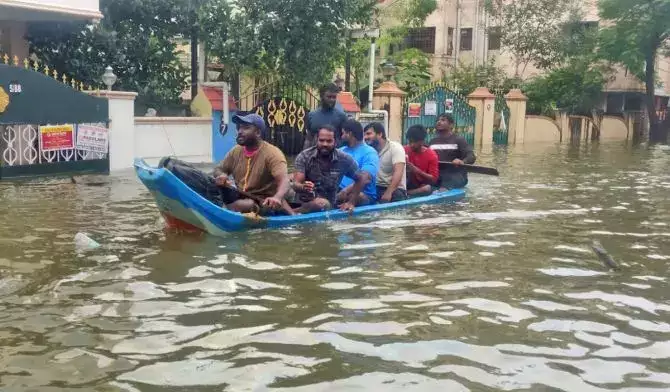
Indian cities are known to have too few public buses. In recent years, however, boats have made frequent appearances. Examples include Chennai and Delhi in 2023, Bengaluru and Ahmedabad in 2022, and Hyderabad in 2021. Floods turned streets into canals, forcing evacuation using boats. Others, such as Kochi, Patna, and Nagpur, also experienced floods in recent years.
Urban flooding is a stark reality, posing severe challenges to vulnerable communities, economic activity, and critical infrastructure. According to CSE, India experienced heavy rain and floods every other day in the first nine months of 2023. About 2000 lives were lost, and economic damage is estimated to have exceeded ₹40,000 crores.
The increasing frequency of extreme events and the pace of urbanisation require cities to prioritise mitigating this risk and minimising the damage. Various factors are responsible, including unplanned urbanisation, poor and inadequate infrastructure, and the impacts of climate change.
Therefore, a comprehensive response will be required, including revamping urban planning, improved infrastructure, robust policies, and disaster management guidelines. Since our cities have limited resources, low-cost, nature-based solutions, partnerships to leverage private resources, and community participation will be essential.
To begin with, cities need to recognise the nature and magnitude of the risk. A detailed flood risk analysis is crucial to understanding water flows, mapping infrastructure assets and demography, and assessing various scenarios. Urban flooding strategies need to be tailored based on city-specific risks. The toolbox should include a mix of policy interventions, green-blue infrastructure, climate-resilient housing, and active community engagement.
On the infrastructure side, three initiatives can make a difference. First, investment is required to redevelop natural water sinks and rejuvenate water channels. A comprehensive strategy should be developed, considering watersheds, urban rivers, and topography. The focus should be channelling water flow from high-risk areas to predetermined storage facilities. It is possible to attract the private sector through value capture by co-developing nature-based eco-parks and securing green credits.
Cities like Chennai and Kochi are increasingly adopting green-blue infrastructure planning. This involves integrating natural features like wetlands and green spaces into urban planning to manage stormwater,
reduce flooding, and enhance the overall ecological health of the area. Coimbatore revitalised its historical seven lakes that became integral to the water supply system and acted as efficient flood buffers.
Delhi presents an exciting example of a decentralised stormwater management project, demonstrating the integration of green infrastructure. Incorporating permeable pavements, green roofs, and rain gardens has reduced surface runoff and increased the ability to absorb rainwater. This reduced the risk of urban flooding and revitalised the local ecosystem. Thiruvananthapuram has also implemented decentralised stormwater management strategies, including rain gardens and permeable pavements.
The Miyawaki Forest initiative in Pune enhanced urban resilience through tree planting. It created dense, self-sustainable forests in urban spaces, improving air quality, increasing biodiversity, and enhancing resilience to climate impacts like floods.
Second, the development of well-designed construction and demolition (C&D) waste recycling facilities. Though C&D Rules 2016 mandate them, few cities have developed one. C&D waste continues to be dumped in rivers and lakes, blocking the natural water channels. The cost of developing these projects is relatively modest, but land availability and mindset challenges are significant bottlenecks. So, state-level policies are required to address these and attract private investment.
Third, innovative design and enhanced standards for infrastructure are essential as cities look to expand drainage systems. In many cities, retrofitting existing structures is required. The Mumbai Repair and Reconstruction Board (MRRB) has initiated retrofitting projects in flood-prone areas, demonstrating the feasibility of enhancing the resilience of existing structures. However, new and innovative projects will also be required. Kaula Lampur’s innovative Stormwater Management and Road Tunnel (SMART) is a classic example. It is a multi-layered tunnel system that simultaneously solves the problem of flash floods and traffic jams along the city’s central corridor.
Since floods cannot be ruled out, constructing climate-resilient housing, particularly for vulnerable communities, is critical. Gurjapur, in Bihar, where floods are common, has developed elevated houses that have proven effective. The Sundarbans, vulnerable to cyclones and tidal surges, have also developed resilient homes. Elevated on concrete pillars, these houses are designed to withstand flooding and cyclonic winds, offering a protective shelter for residents.
Vulnerable communities need to be at the heart of risk assessment and management. Mapping vulnerable areas enables the formulation of precise evacuation plans and strategies. For instance, Ahmedabad's participatory risk assessment approach has ensured an accurate understanding of local vulnerabilities by actively engaging local communities in identifying and mapping flood-prone areas. The result is a tailored set of measures that align with each community's particular needs and challenges, fostering a sense of ownership and resilience.
Disaster management committees can raise awareness and provide specialized training for early response and management. For instance, Mumbai's Advanced Locality Management (ALM) system empowers citizens to participate actively in flood management. It facilitates swift rescue operations and contributes to post-flood recovery efforts.
Integrating technology can further enhance the benefits. Utilizing mobile applications and early warning systems enhances communication. Kerala's use of the 'Sahyadri' app during the 2019 floods exemplified real-time information and guidance to residents, enabling them to make informed decisions during critical situations. These digital tools transformed how citizens interacted with their local government, allowing them to participate actively in decision-making. The importance of these platforms was evident during the COVID-19 pandemic and recent flood emergencies.
Community-based drills and simulations can play a pivotal role in preparing residents for potential flooding. The National Disaster Management Authority (NDMA) has successfully conducted large-scale mock drills to foster community participation and enhance preparedness. Along with the NDMA, state and district disaster management committees must be activated.
The Centre must take the lead, at least for now. In 2023, two key initiatives were launched. The PM e-bus scheme will enable 10,000 electric buses in 169 cities in August. In December, the Chennai Integrated Flood Management Project was announced. Both are welcome and applaudable. We recommend expanding both in 2024 to increase the number of buses and reduce the occurrence of boats in our cities.